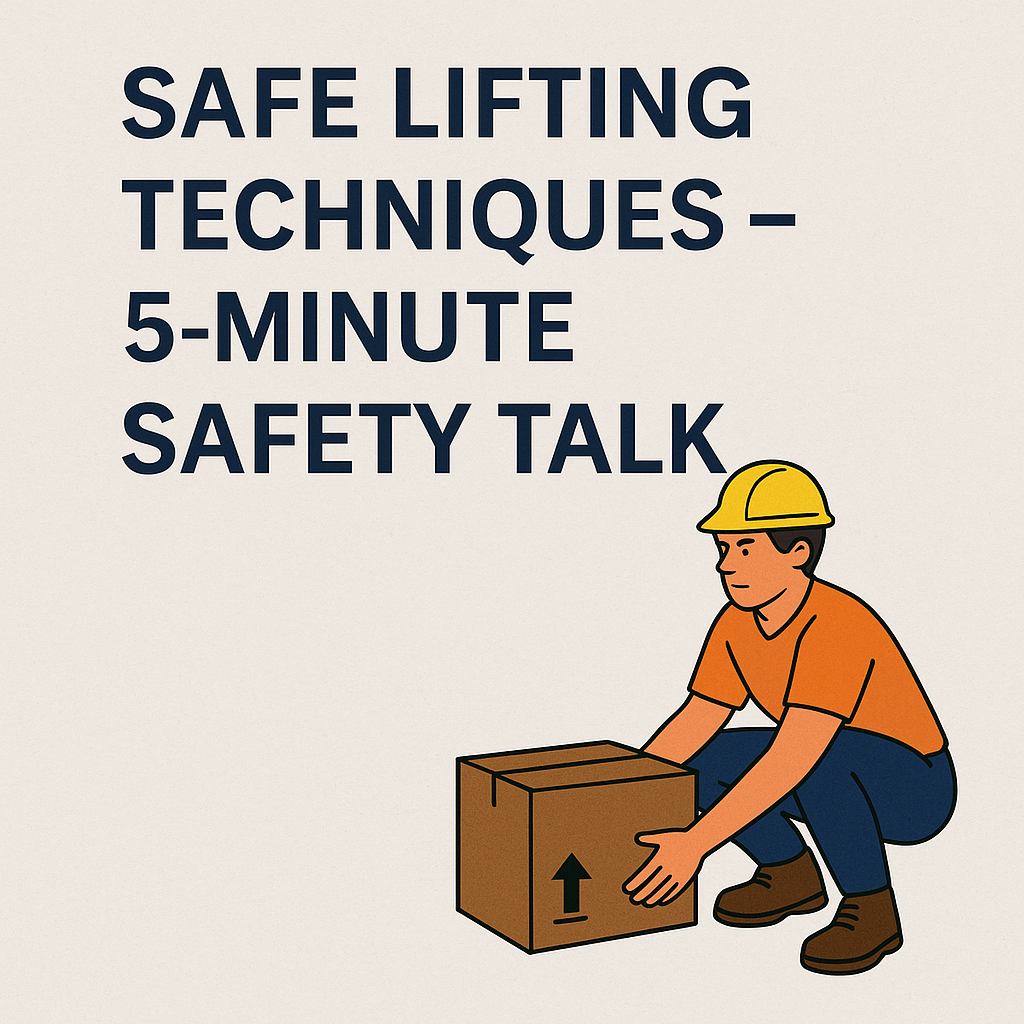
Safe Lifting Techniques 5 Minute Safety Talk
Good morning team,
Today, we’re going to talk about something we all do on the job—lifting. Whether it’s moving a box of tools, carrying a bag of cement, or shifting materials on a site, lifting is part of our daily routine.
But lifting incorrectly can lead to serious injuries—especially back strains, muscle tears, and even slipped discs. The truth is, most lifting injuries are 100% preventable. That’s why safe lifting techniques matter.
Let’s spend the next five minutes reviewing how to lift smart, stay safe, and protect our backs for the long haul.
Why Safe Lifting Is Important
Manual handling is one of the leading causes of workplace injuries. In fact, back injuries alone are a top reason workers miss time on the job.
Injuries from poor lifting include:
- Lower back pain
- Herniated discs
- Muscle and ligament strain
- Shoulder and knee injuries
- Long-term disability
All from one wrong move. That’s why every lift matters.
When Do You Need to Use Proper Lifting Techniques?
- Lifting anything over 10–15 kg
- Awkward or uneven loads
- Lifting while bending, twisting, or reaching
- Repeated lifting throughout the day
- Working in confined spaces
Even lightweight items can cause injury if lifted improperly.
Think Before You Lift – Plan It Out
Before you even touch the object:
- Size it up – Can you lift it safely alone?
- Check the path – Clear obstacles or tripping hazards
- Know where you’re going – Avoid awkward turns
- Test the weight – Nudge it with your foot to see how heavy it is
- Ask for help or use equipment if it’s too heavy
The best way to prevent an injury is to avoid unsafe lifting altogether.
Step-by-Step: How to Lift Safely
Follow these steps every time you lift:
- Stand close to the load
- Position your feet shoulder-width apart
- Bend your knees—not your back
- Keep your back straight and chest forward
- Get a good grip with both hands
- Lift slowly using your legs
- Keep the load close to your body
- Avoid twisting—turn with your feet, not your torso
- Lower the load slowly by bending your knees again
Remember: Lift with your legs—not your back.
Common Lifting Mistakes to Avoid
- Bending at the waist
- Twisting your body while lifting
- Lifting with one hand or uneven grip
- Rushing the lift
- Holding objects away from your body
- Ignoring fatigue or pain
One wrong move could mean weeks off the job—or worse.
Use Tools and Equipment
Don’t rely only on your body when tools can help.
- Use dollies, trolleys, forklifts, or hand trucks
- Install lift tables or hoists for repetitive tasks
- Use slings or straps for awkward objects
- Team lift whenever possible
Work smarter, not harder.
PPE for Manual Handling
Depending on the environment, you might need:
- Gloves for grip and protection
- Steel-toe boots to protect your feet if you drop something
- Back support belts (only when properly fitted and recommended)
- Non-slip soles for better footing
PPE doesn’t prevent strain, but it reduces your risk.
Safe Lifting Checklist
Before lifting, ask yourself:
- Is the object too heavy or awkward for one person?
- Is my path clear of tripping hazards?
- Am I wearing the right footwear or gloves?
- Do I have a solid grip on the load?
- Can I lift using proper form?
If the answer to any of these is no, stop and rethink the lift.
Real-Life Example
A warehouse worker attempted to lift a heavy box alone instead of asking for help. He twisted while lifting and ended up tearing a ligament in his lower back.
Result: 3 months of missed work, ongoing pain, and physical therapy.
All because he didn’t follow proper lifting technique.
Train Your Body and Your Mind
Lifting safely isn’t just about your back—it’s about your mindset:
- Don’t rush
- Don’t compete with others
- Don’t ignore pain
- Speak up if something feels off
- Encourage teammates to lift safely too
Good habits protect you every day.
Conclusion
Lifting is part of the job—but getting hurt doesn’t have to be. Most lifting injuries happen not because something is too heavy, but because it was lifted incorrectly.
So remember:
- Plan before you lift
- Use your legs, not your back
- Keep the load close
- Ask for help or use equipment
- Take your time
Your back is one of the most important tools you have—protect it.
Slips Trips and Falls 5 Minute Safety Talk
Fire Safety 5 Minute Safety Talk
Electrical Safety 5 Minute Safety Talk
Personal Protective Equipment – PPE 5 Minute Safety Talk
Housekeeping 5 Minute Safety Talk
5 Unique FAQs
Q1: Is it safe to lift with a back brace?
Back braces can provide support, but they’re not a substitute for proper technique. Only use them if approved by safety guidelines or medical advice.
Q2: What should I do if I feel pain while lifting?
Stop immediately. Report the incident, and don’t continue working until you’re assessed.
Q3: Can lifting light loads still cause injury?
Yes—especially with poor posture, repetitive motion, or twisting while lifting.
Q4: How do I know when to ask for help lifting?
If it’s too heavy to lift comfortably or you can’t get a firm grip—ask for help or use equipment.
Q5: Should I stretch before lifting?
Yes! Simple stretches before manual handling tasks can improve flexibility and reduce the risk of muscle strain.